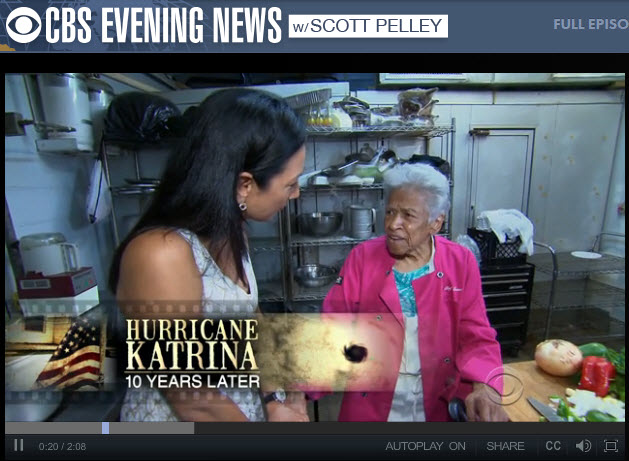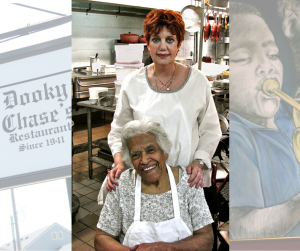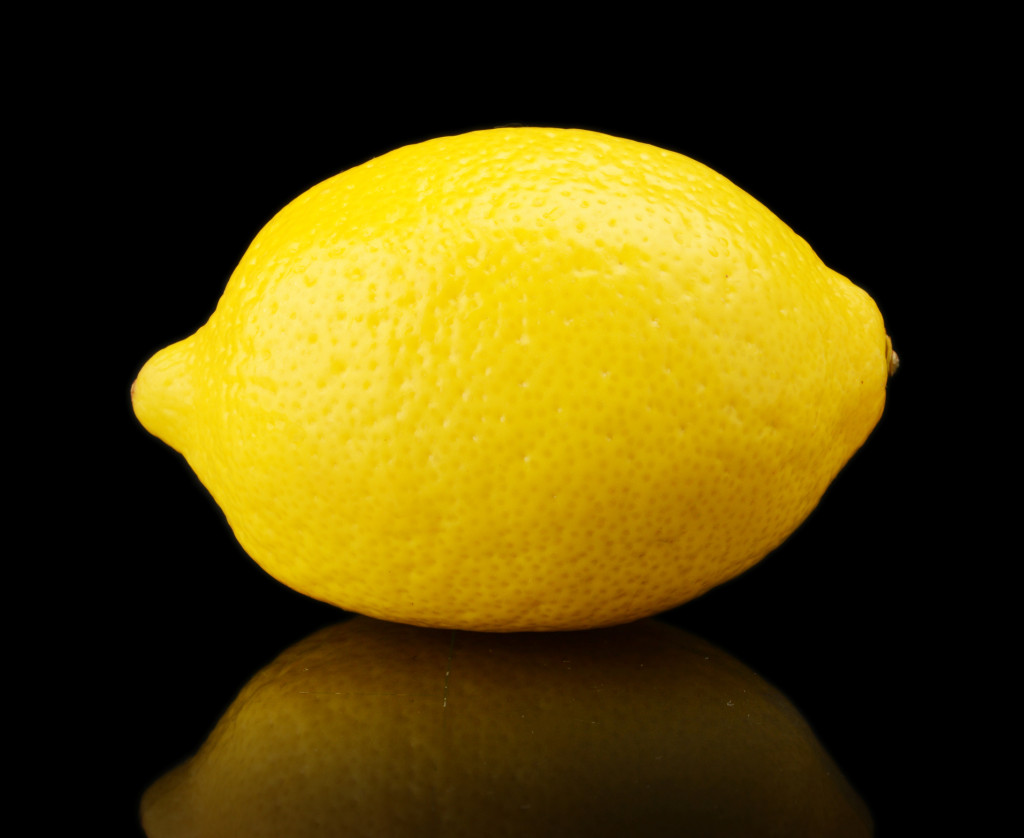Leah Chase and colors of foods
A Gift for Leah Chase -“The Secret Powers of Colorful Foods”
I recently visited New Orleans and had dinner at Dooky Chase’s restaurant. The chef and owner, Leah Chase, is a nationally prominent figure and a cookbook author who is also known as “the queen of creole cuisine.”
I was fortunate to have met Leah Chase some twenty years before when I interviewed Leah at her restaurant in preparation for a radio commercial and print ad. It was for Lawry’s Seasoned salt, a commercial blend of herbs and spices. I will never forget the chat we had and how charismatic Leah was. I felt I was in the presence of greatness. Yet, her humility and openness invited a personal connection that I feel to this day. Her cooking was superb. I also enjoyed the recipes in her cookbook that I purchased and made at home. White Beans with Collards, Turnips and Green Peas in Cream Sauce, Dooky Sauce for shrimp or crab meat and Sweet Potato Dressing are my favorites. Leah had an intuitive feel for herbs and spices and fruit and vegetables – she was already an aficionado of all colors of foods.
I was filled with excitement to see Leah again, hear her soft spoken voice, and enjoy her energy when she talked about food.
Leah recognized me and the years melted away. After we briefly reminisced in her restaurant kitchen, I proudly handed her the book I wrote with Charlotte Lyons, “The Secret Powers of Colorful Foods.” As she thumbed through it, a look of amazement came over her face.
She said, “You know, this is truly unique. I have never seen such a book. It’s so different, it is exciting! She added, “I have always been fascinated by colors of foods. I am always telling people to have more colors of foods on their plate. This answers a lot of questions.” She spent time looking at the book more closely, then looked up at me and said, “You know, I think I need more orange!”
Leah’s quick understanding of the book – that different colors of foods can enhance different emotions – pleased me. Her enthusiasm was sincere and exciting.
After we said our goodbyes, I couldn’t help but wonder. What orange recipes will Leah create? I am sure they will be absolutely delicious.
Foods For Feelings
Making our feelings more positive
How positive are your feelings? You may be smiling on the outside, but deep down hurts, resentments, fears and feelings of not being enough may be hiding. When we don’t acknowledge them and use tools to make them more positive, they express themselves as physical illness in the body.
These days, we are so addicted to computers and cell phones and television that we don’t have the space to truly get in touch with our innermost thoughts and feelings. Online, we share with friends and family what we are doing, where we have been, how our job is going. That is in cyberspace. But what about our inner space?
When we are not mindful or fully aware of our feelings, we override them by going through the motions of every day life.
Often we swallow our feelings with generous helpings of food. We eat comfort foods to suppress feelings of sadness or insecurity. Or eat mindlessly when we feel stuck in life or feel very small.
In our book, The Secret Powers Of Colorful Foods, Charlotte Lyons and I share a food color matching technique to assist balancing emotions, feelings and attitudes that need a boost
Here’s how it works
Based on ancient Hindu belief, the human body has chakras or energy currents running along the spine whose circular spinning frequencies emit a different color for each of our emotions. Colors of emotions react positively to similar colors of food. And food colors can boost emotional energy.
Let’s say your feelings of confidence are low. Yellow is the color of the food to eat to raise the energetic frequency of personal power. Or, maybe you are in a creative slump. You might like to eat some orange yams or orange foods that correspond to creativity and going with the flow in life.
Yesterday, a reader shared that she had cravings for broccoli and spinach. Of course, on a physical level, she may have a deficiency in vitamin C or potassium that the body needs. But metaphysically and emotionally, the color green relates to nurturing, kindness, forgiveness and opening up the heart to giving and receiving love. I asked her to write down her feelings as she ate the green foods. What comes up emotionally? Could it be an ancient hurt like abandonment that she can’t forgive? That’s just one example. Or maybe she has cut off the ability to love. What feelings does she have about that. It will be interesting to see what she comes up with.
Eating different food colors can help boost positive feelings
The Secret Powers Of Colorful Foods give us the tools to strengthen positive feelings with food color matching charts, meditations, affirmations and food fun facts.
Plus, Charlotte Lyons wrote simple recipes for each color and how to do purees – a simple way to get different colors going for you.
The Secret Powers Of Colorful Foods helps you to be mindful of what you are feeling and gives you the tools to empower feelings that are weak.
Once you use this food color matching technique for your feelings and emotions you will see and feel how empowering it can be.
Next time you go to the supermarket go to the produce section. Check in with your feelings. Head to the color you need to work on. And you’re off to a good start!
Feeding Your Emotional Energy
You Are Looking At Your Self-Esteem.
“You are braver than you believe, smarter than you seem, and stronger than you think.” – Winnie the Poo
According to our book, “The Secret Powers of Colorful Foods,” different colors of foods support different attitudes, feelings and emotional energy. Different emotions generate different colors because their energy vibrates to different frequencies. When you understand how emotional energy centers of the body correspond to colors of foods, you can go to the market and instead of selecting foods for taste alone, you can also select them to support your own emotional needs. And that’s quite empowering!
Know Your Yellow Feelings
Found in your solar plexus, just below the breastbone and above your navel – to find it easily, put your hands around your waist – is yellow chakra energy. This is where our conscious thoughts and opinions are formed and controlled. It is also where our gut instincts are. So often we neglect them when they are telling us important information.
To support those gut feelings, yellow foods are a valuable tool.
Yellow foods can also combat the blues which very often stem from fear and a feeling a lack of confidence. Yellow is the color of the sun and represents your personal power, self-esteem, metabolism and digestion. It is the color that supports thinking, your sense of who you are, the power within you, the power you have over others and the power others have over you. It also relates to cheerfulness and enjoyment of new challenges.
When we are exposed to sunshine, the day is clear and bright. So too, our Solar Plexus Chakra (yellow energy center) shines a light in which we see ourselves and appreciation of our self-worth. Next time you are feeling low, lack self-confidence or feel mentally fuzzy, head to the yellow foods in your market and select a fruits, vegetables, herbs or spices that most appeal to you.
You will find Charlotte Lyons’ delicious yellow recipes in the Yellow chapter of our book, “The Secret Powers Of Colorful Foods.” My personal favorite is the Aztec Corn Soup on page 57.
You can get a taste of Charlotte’s simple Lemon Vinaigrette recipe here for starters.
Lemon Vinaigrette
2 tablespoons white wine vinegar
2 tablespoons fresh lemon juice
1 teaspoon Dijon mustard
1 teaspoon lemon zest
1 teaspoon honey or agave
½ teaspoon sea salt
¼ teaspoon ground white pepper
Dash garlic powder
2/3 cup olive oil
1. Combine the vinegar, lemon juice, mustard, lemon zest, honey, salt, pepper, and garlic powder in medium, whisking to blend.
2. Gradually add the olive oil in thin stream, whisking constantly until well blended and smooth. Adjust seasoning if needed.
Yields about 1 cup
Feeding Your Subconscious Mind
The words you use can cause more anxiety than you think.
In our book, “The Secret Powers Of Colorful Foods,” we talk about different colors of foods supporting different emotions, feelings, attitudes, even our spirituality. Once you’ve determined the feeling, attitude or emotion you want to work on, you select food of a similar color and use the recipes in the book – or create your own.
Nourishing our body energetically with color for emotional benefit is one thing. Another is seeing words as foods that feed our subconscious mind positively or negatively. As writers, Both Charlotte and I are intrigued by the power of words and they way they affect us. The Aquamarine chapter of “The Secret Powers Of Colorful Foods” all about self-expression and speaking one’s truth. We explore the secrets some words hide.
Take the word hope, for example. How many times a day do you hear it? How many times do you use it? When you say, “I hope so,” it sounds positive, but it is shadowed by doom – it is a surrender to helplessness and the belief we cannot fulfill our own needs. Using the word hope leads to disappointment and promotes a feeling of anxiety – the subtle dread that something bad is about to happen.
A remedy to using the “hope word” is first to catch yourself using it. Then replace it with ‘I have confidence” or “I trust” or I am optimistic.” Feel the shift that positive energy makes? That’s because it gives commitment and provides security. So, when I say “I have confidence that you will use a more confident expression to replace the word hope, ” I am empowering my subconscious mind as well as yours. Be consistent in replacing the word with a positive one, because it takes repetition to break a habit.
Another word that negatively feeds the subconscious mind is “should.” Plain and simple, it implies punishment. It is that parental finger pointing at you. Catch yourself using it and replace it with the words, “I’d like to” which suggest a goal and a desire without pressure. Can you feel how changing words puts you in the driver’s seat without the anxiety of punishment? It’s a powerful tool.
In the “You Can Heal Your Life Workbook,” author Louise Hay states, “…I believe that ‘should’ is one of the most damaging words in our language. Every time we use should, we are in effect saying ‘wrong.’ Either we are wrong or were wrong or we are going to be wrong. I don’t think we need more wrongs in our life. We need to have more freedom of choices.”
Deleting the words “hope” and “should” from our vocabulary can help alleviate anxiety. Your subconscious mind will thank you!






